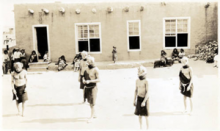Article
In several Pueblo traditions, the Mudhead Clown is a masked figure who works as disciplinarian, joker, and village cryer. The early Hopi variation of this figure is called Tachukti, meaning “Ball-On-Head”; however, around 1860 the Zuni variation, known as Koyemsi or Koyemshi, rose to prominence in cultural studies of the western Pueblos. The anglicized term "Mudhead Clown" derives from the appearance of the Koyemsi mask, which is covered with loosely-formed mud balls that form vaguely human-like features. Mudhead Clowns can be garbed in a black dress with a red or brown-clay painted body.
According to the Zuni origin legends, the father or head Koyemsi incestuously produced nine children with his sister. In his remorse for this heinous act the father beat himself and rolled in the mud until his head was covered in bulbous welts coated in mud. Upon their birth, the children of this union resembled their father, appearing with faces and bodies disorted by various mud-covered protuberances. The incestuous nature of their conception bars the Koyemsi from becoming kachinas themselves. Instead, they act in secondary roles, such as spokespersons for the other kachinas. While neither a priest nor ceremonial dancer, the Mudhead Clown is a part of many social gatherings, performing as curers, directors, warriors, messengers, sages, and tricksters.
"Mudhead kachina dance in plaza, circa 1920-1939," photograph by Unknown. Elizabeth Willis de Huff Colelction (000-099-0324). Center for Southwest Research, University of New Mexico.
Manuscripts
References
Clemmer, Richard O.
1995 Roads in the Sky: The Hopi Indians in a Century of Change. Boulder: Westview Press.
Hieb, Louis A.
1972 The Hopi Ritual Clown: Life as It Should Be. Ann Arbor: University of Michigan.
Wright, Barton
1994 Clowns of the Hopi: Tradition Keepers and Delight Makers. Flagstaff, Arizona:
Northland Publication.

